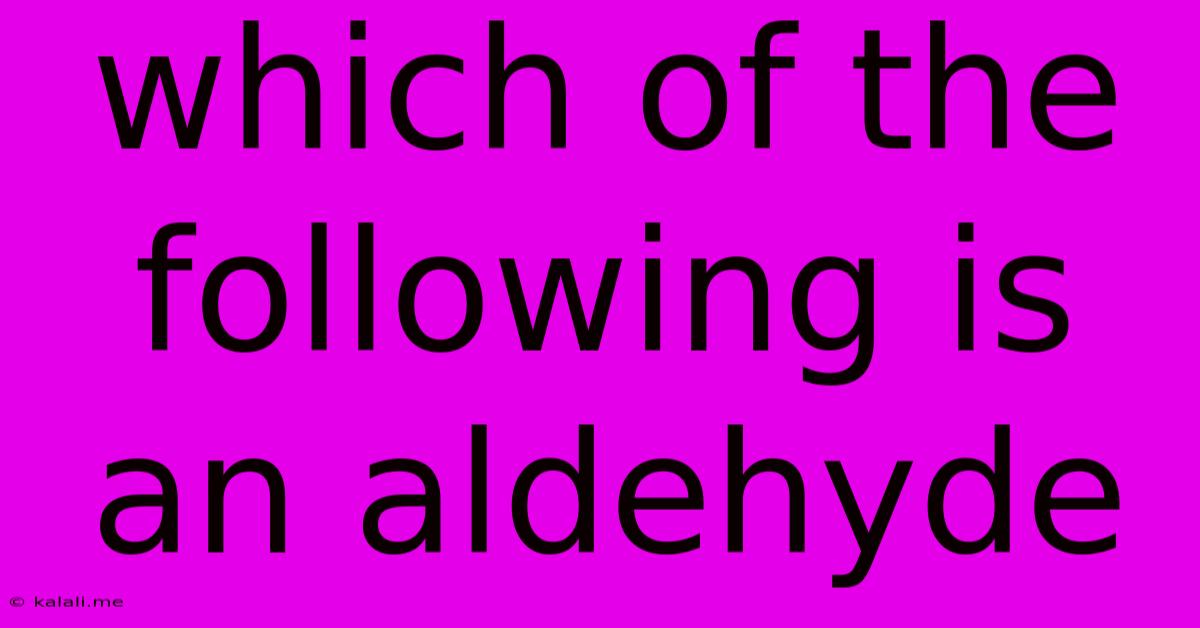Which Of The Following Is An Aldehyde
Kalali
Jun 13, 2025 · 3 min read

Table of Contents
Which of the Following is an Aldehyde? Understanding Functional Groups in Organic Chemistry
This article will explore the fascinating world of organic chemistry, focusing on identifying aldehydes among various organic compounds. We'll define aldehydes, explain their key characteristics, and provide examples to help you easily distinguish them from other functional groups. Understanding aldehydes is crucial for anyone studying organic chemistry, as they play significant roles in numerous biological and industrial processes.
What is an Aldehyde?
Aldehydes are organic compounds characterized by a carbonyl group (C=O) bonded to at least one hydrogen atom. This specific arrangement of atoms defines the aldehyde functional group. The general formula for an aldehyde is RCHO, where 'R' represents any alkyl or aryl group (a carbon-containing chain or ring). The carbonyl group is highly reactive, making aldehydes important participants in many chemical reactions.
Key Characteristics of Aldehydes:
- Carbonyl Group: The presence of a carbonyl group (C=O) is the defining feature of an aldehyde.
- Hydrogen Atom: Crucially, one of the carbon atoms in the carbonyl group must be bonded to a hydrogen atom. This differentiates aldehydes from ketones, which have two carbon atoms bonded to the carbonyl carbon.
- Reactivity: Aldehydes are generally more reactive than ketones due to the presence of the hydrogen atom attached to the carbonyl group. This hydrogen is susceptible to oxidation and other reactions.
- Nomenclature: Aldehydes are typically named by replacing the "-e" ending of the corresponding alkane with "-al". For example, methanal (formaldehyde) and ethanal (acetaldehyde).
Distinguishing Aldehydes from Other Functional Groups:
To accurately identify an aldehyde, it's essential to differentiate it from other organic functional groups, particularly ketones, carboxylic acids, and alcohols.
- Ketones: Ketones also contain a carbonyl group (C=O), but the carbonyl carbon is bonded to two alkyl or aryl groups, rather than a hydrogen atom. This is the crucial difference.
- Carboxylic Acids: Carboxylic acids contain a carboxyl group (-COOH), which consists of a carbonyl group bonded to a hydroxyl group (-OH). This gives them acidic properties, unlike aldehydes.
- Alcohols: Alcohols contain a hydroxyl group (-OH) bonded to a carbon atom. They lack the carbonyl group that defines aldehydes and ketones.
Examples of Aldehydes:
Let's look at some common aldehydes:
- Formaldehyde (Methanal): The simplest aldehyde, with the formula HCHO. It's a colorless gas with a pungent odor and is used in various industrial applications.
- Acetaldehyde (Ethanal): Has the formula CH₃CHO. It's a colorless liquid with a characteristic fruity odor.
- Benzaldehyde: An aromatic aldehyde with the formula C₆H₅CHO, responsible for the characteristic odor of almonds. It's commonly used in perfumes and flavorings.
- Glyceraldehyde: A simple sugar (aldotriose) that plays a vital role in various metabolic pathways.
In Conclusion:
Identifying an aldehyde requires a careful examination of its molecular structure. The presence of a carbonyl group (C=O) bonded to at least one hydrogen atom is the definitive characteristic. By understanding the key features of aldehydes and contrasting them with similar functional groups, you can confidently identify them in a variety of organic molecules. This knowledge is foundational to deeper studies in organic chemistry and related fields.
Latest Posts
Latest Posts
-
What Are The Factors For 67
Jun 14, 2025
-
Which Era Is Known As The Age Of Mammals
Jun 14, 2025
-
Bengal Famine Was Caused Due To Which Disease
Jun 14, 2025
-
How Fast Does A Peacock Run
Jun 14, 2025
-
Which Of These Lines Is A Metaphor
Jun 14, 2025
Related Post
Thank you for visiting our website which covers about Which Of The Following Is An Aldehyde . We hope the information provided has been useful to you. Feel free to contact us if you have any questions or need further assistance. See you next time and don't miss to bookmark.